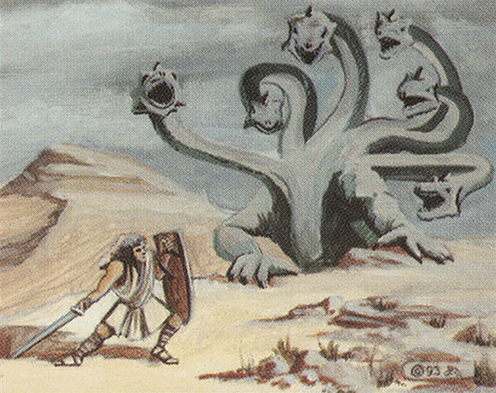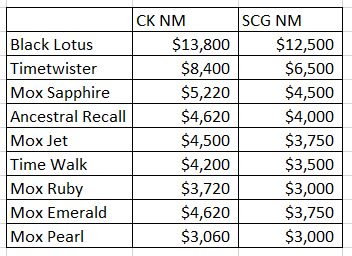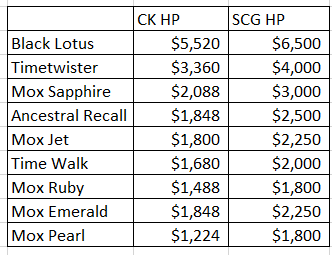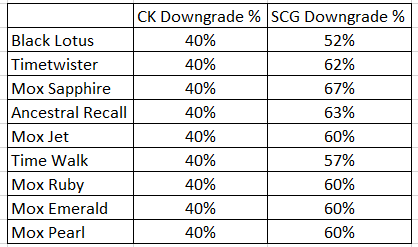Are you a Quiet Speculation member?
If not, now is a perfect time to join up! Our powerful tools, breaking-news analysis, and exclusive Discord channel will make sure you stay up to date and ahead of the curve.
When I first started writing about Magic finance over a decade ago, I frequently referenced Star City Games as the gold standard for pricing—both on the buy-side and the sell-side. In fact, the first buylist that I used on a consistent basis was Star City Games’. I remember typing up my buylist orders in an email, following a very particular format required by the site, waiting for the approval email, and then printing out the approval email to ship along with the cards.
Thank goodness times have changed since then.
They changed so much, in fact, that I consider Card Kingdom’s buylist as best in class now rather than Star City’s. During the last cycle of peak Old School card prices, I shipped numerous trade-in and cash buylist orders to Card Kingdom, taking advantage of their aggressive prices and generous payouts. I haven’t sold a card to Star City Games through their website since March 2016.
Card Kingdom does have one minor shortcoming with their buylist that I wish they’d correct, however. ABUGames and Star City Games already changed their system, irradicating this issue, but Card Kingdom has not addressed it yet. It only impacts three sets, and only cards printed in 1993. I’m talking about their downgrade percentages for Alpha, Beta, and Unlimited cards.
Constant Percentage for Condition Downgrades
When it comes to downgrade percentages, Card Kingdom still uses constant numbers based on the card’s value—the higher the value, the higher percentage of the near mint price you receive for played copies. Foils get their own downgrade scale as do Alpha, Beta, and Unlimited cards. Here’s the simple summary:
When it comes to selling Card Kingdom played cards worth over $100, you’ll often not get a better deal than from Card Kingdom. For example, you can sell a heavily played Library of Alexandria to Card Kingdom for 70% of $1,690, equaling $1,183. Star City Games offers $1,000 and ABUGames $918 (though $1,900 in store credit). In terms of cash value, you’ll get a good bit more from Card Kingdom.
But when you want to sell a played Alpha, Beta, or Unlimited card (abbreviated ABU for short), you’re looking at a different story. Let’s say you have a heavily played Beta Counterspell for sale. How do the three different vendors differ in their buy prices? Well, Card Kingdom pays 40% of $960, which is $384. Meanwhile Star City Games offers $450! ABUGames hasn’t updated their Beta buy prices in a while, so their offer is irrelevant ($240.98).
The bottom line is Card Kingdom loses some of its competitiveness because of their standard downgrade percentage policy. Card Kingdom only pays 40% of their near mint buy price on “Good” (HP) Beta cards. Star City Games has individual pricing for every card—while this may involve more effort, it allows them much more flexibility when dealing with these highly collectible cards. In the case of Armageddon, SCG offers 60% of their near mint price for an HP copy. So even though Card Kingdom pays better on NM copies, SCG pays best on the played stuff.
One last example I wanted to highlight was the bucket of Unlimited Power Nine. First, let’s compare Card Kingdom’s and Star City’s near mint buy prices:
For all nine cards, Card Kingdom pays better than Star City Games. If you have a nice copy of any of these cards and are itching to sell to a store, Card Kingdom would be the way to go. However, what if your copy is heavily played and would be graded as “Good” condition by Card Kingdom? Suddenly, the comparison isn’t so favorable for Card Kingdom:
When dealing with played condition, Star City Games pays a good bit better than Card Kingdom on every single piece of Power Nine—a complete reversal from near mint. Why does this happen? It’s because Card Kingdom applies a flat 40% multiplier for Unlimited cards they downgrade to “Good”. SCG’s percentage is variable, customized based on the card. Here’s a quick comparison of the downgrade percentages from near mint to heavily played, for comparison:
The difference is clear: applying a customized downgrade percent for a card (presumably based on market data) means Star City Games can be more competitive with their buy prices than Card Kingdom, who applies a constant percentages.
The Implications
Maybe this doesn’t seem like a big deal—you sell your heavily played ABU cards to Star City Games and the nice condition copies to Card Kingdom. Easy enough, right?
While I agree with this strategy in general, I would argue it creates an imbalance in supply when looking to purchase an ABU card. Namely, Card Kingdom ends up with a bunch of EX and VG copies of ABU cards in stock, but rarely has NM and G copies. While they may not get many NM copies simply because the quantity of NM copies of an ABU card is severely limited, I would argue their constant shortage of G copies stems directly from their buylist practices.
Here’s an example: I filtered to Card Kingdom’s Beta cards for sale and then sorted by price, high to low. They have a smattering of high-end Beta cards in stock, including Black Lotus, Timetwister, Ancestral Recall, a couple Dual Lands, etc. But nearly every card they have in stock is graded either EX or VG.
In fact, as I look at their stock of the 100 most valuable cards in Beta (roughly the top third), they have four cards in stock at G condition and five at NM condition, 4% and 5% respectively. The vast majority of their inventory is either EX or VG condition. Again, the low stock of NM inventory could simply reflect their strict grading practices. It could also indicate that collectors are scooping up NM copies with plans to submit for grading.
But on the low condition side, Card Kingdom doesn’t have many “Good” copies of ABU cards for sale because they don’t pay competitively on them. The corollary to this is that Card Kingdom’s sell prices for HP ABU cards are too low relative to the rest of the market. For example, one of the few G cards Card Kingdom has in stock from Beta is Rock Hydra—their asking price is $220.
Compare that to the cheapest copy for sale on TCGplayer, which is $355. EBay’s cheapest listing is $300, also higher than Card Kingdom’s G copy. While CK’s copy is likely in worse condition than these two other listings, the bottom line is Card Kingdom’s HP copy is the cheapest you can find. It wouldn’t surprise me if that copy was scooped up soon, especially since you can regularly obtain Card Kingdom store credit at a rate of 85%, meaning you can bring your cash price on this card down to $187!
My Call for Action to Card Kingdom
Years and years ago, before Old School was a format and before Alpha and Beta cards were so highly regarded for their rarity and collectability, players were disinterested in played stuff from Magic’s earliest sets. Collectors still existed, but they focused on the nicer copies since they were relatively affordable (compared to today’s prices).
Because of this historical trend, it made sense for vendors to pay aggressively for near mint copies—it’s what collectors were after. Meanwhile, a heavily played Beta rare that saw no tournament play would rot in inventory for ages. I believe this is what led to the significant downgrade percentage practice adopted by Card Kingdom.
But times have changed, and I’d make the argument to Card Kingdom (and every other vendor still using a constant percentage downgrade model on ABU cards) that it’s time to customize these percentages to reflect modern day market dynamics. The reality is, there are a bevy of Old School collectors out there who aren’t so picky on condition anymore. Prices have gotten so high that we have begun embracing played and heavily played copies in order to afford cards for our collection. As long as the card isn’t completely damaged and inked, I don’t care if there’s some edge and surface wear on my Alpha and Beta cards—I can still appreciate their nostalgia regardless.
In addition, Old School players want these once-forgotten cards for actual play!
When was the last time you saw a Hypnotic Specter at a tournament table? Due to power creep, the uncommon has become completely outclassed. But the card is a powerhouse and a staple in Old School. The result: HP copies sell for $300 and MP copies for close to $400!
Because these cards are going to be shuffled by players, you may have an easier time selling HP and MP copies of Beta Hypnotic Specter vs. NM copies. Therefore, it makes little sense to offer such a competitive number on near mint copies, but such an abysmal number on the HP copies. The Old School ABU cards that see play demand higher price points for played copies—these are the copies we want to shuffle up in decks!
Therefore, my call to Card Kingdom is to abolish the standard downgrade percentage practice on ABU cards. I know this will take greater effort, but I know the site already has some sort of proprietary algorithm they use to calculate their buy prices. Perhaps a small upgrade to their algorithm is all they need to implement a more dynamic model for ABU cards.
The hardest part of implementation may not be identifying the algorithm to use (they likely have the data they need already), but updating the website’s code to enable a different interface that showcases the variable downgrade percentages. I’m not a coder, so I don’t know what this may entail. But if Card Kingdom wishes to increase their transactions and improve their inventory on ABU cards, they should consider making this change.
Wrapping It Up
Every time I obtain store credit to Card Kingdom, I try to spend it on a “Good” condition copy of an ABU card. The reason is simple: their prices on these cards are often too low, even discounted relative to the open market. This opportunity stems from their [arguably] antiquated approach to buying ABU cards: a constant downgrade percentage calculation.
Times have changed, Old School players and collectors are content to purchase HP and MP cards to build their decks and fill out their collections. Therefore, I’d argue more favorable downgrade percentages are merited on many ABU cards. This is especially true for Alpha and Beta rares, where supply is so low that I’m willing to grab any affordable copy for my collection. I’ve even been able to quickly sell Alpha and Beta Purelaces with little effort. There is a market for the unplayable rares, simply due to their rarity and collectability.
Star City Games has caught onto this new market dynamic. I hope Card Kingdom will follow suit soon. Otherwise, they can expect to carry an inventory riddled with overpriced EX and VG copies and virtually zero NM and G copies. This trend alone should be a strong indicator to Card Kingdom that their practice could use a little updating.
In the meantime, my recommendation is simple: buy G cards from Card Kingdom if you can catch a restock, sell your NM and EX ABU cards to Card Kingdom to take advantage of their attractive buy prices, and sell your HP cards to Star City Games to get the most for your cards. Actually, if you really want to maximize your ABU collection’s value, you should sell directly to Old School players and collectors—we will gladly purchase your HP Webs and Purelaces, and will likely pay more than any vendor will offer.
It doesn’t matter how unplayable the rares are. When only about 1,100 Alpha and 3,200 Beta copies of a rare exist, grabbing any of them at a good price is an attractive way to own a piece of Magic’s history.











hey Sig, I’ve been waiting for you to write this article, not because I agree with you, but because I disagree with you. If you look around the web, other vendors HP cards never sell. they are way over priced. Check out the price on SCG for an HP UNL Mox Sapphire. $6000? Are you kidding me? That’s almost 2x what you sold you card for recently (albeit in a private sale, the point remains that NO ONE is buying at that price)! While CK might not reward people buylisting HP ABU core set cards, for those of us that buy they are fairly price in the market. if you simply increase the buy list and have the sale price go up, the cards no longer will sell and will sit at an inflated price on the market just like the EX and VG cards you complain about. Yes, restock comes far less often as a result and I get this is a site geared towards making money, but for those of us that just want to play with these sweet old cards it’s an absolutely terrible proposition.
As a point of discussion, I’d argue that CK needs to flatted the pricing on their EX and VG cards more than futzing with the G card prices. Cards at G prices generally move, the cards at EX and VG don’t; wonder why that is?
When it comes to grading cards as near mint, excellent, very good, and good, Card Kingdom has a very interesting system. It would rather sell a near mint card as excellent if there’s any doubt about the quality of its condition. As a result I have found many near mint gems sold as excellent. I’ve gone as far as comparing two different Alpha lands one sold as near mint and the other as excellent and both look virtually identical. At that point I simply make the upgrade myself if its clearly a near mint. It does compensate pretty well for those near mints that turn out to be off centered. The Alpha Uthden Troll I received is so off centered it actually reaches the edge. A major misprint actually. I’m happy to keep it. It feels like I’ve gotten far more in return for it. I’m a happy customer.